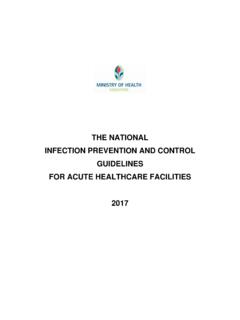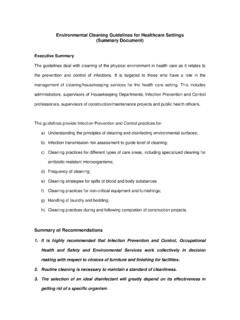Transcription of These guidelines have been withdrawn
1 These guidelines have been withdrawn MOH clinical practice guidelines are considered withdrawn five years after publication unless otherwise specified in individual guidelines . Users should keep in mind that evidence-based guidelines are only as current as the evidence that supports them and new evidence can supersede recommendations made in the guidelines . CLINICAL PRACTICE guidelines . Management of Drug Overdose and Poisoning Ministry National Pharmaceutical May 2000. of Health Administration MOH Clinical Practice guidelines 2/2000. Published by Ministry of Health, Singapore 2000. This publication is meant as a general guide to the management of drug overdose and poisoning and not as an authoritative reference on the subject. Because of the dynamic nature of information on poisoning, readers are advised that decisions regarding drug therapy must be based on the independent judgement of the clinician, changing information about a drug/.
2 Chemical and changing medical practices. While care has been taken to ensure the accuracy of the information presented at the time of publishing, the Ministry of Health, the authors, and the publishing editors will not be liable for any errors or omissions, or any untoward effect arising from the use or misuse of this book. Management of Drug Overdose &. Poisoning I. Message Clinical toxicology has advanced considerably in the last 10 years since the publication of the first handbook on the management of poisoning by the Ministry of Health. The pattern of poisoning has also changed as people are now exposed to other new drugs and chemicals. New antidotes and therapies have been developed for the management of such poisoning, and are now available to health professionals. The publication of this new edition on the management of drug overdose and poisoning is most timely.
3 The workgroup has put in great efforts to produce this comprehensive handbook, which will serve as a quick and easy reference for health professionals in the management of poisoning. I would like to congratulate the workgroup members and all contributors for their achievement. I trust that the handbook will meet the information requirements of our healthcare workers. Dr Chen Ai Ju Director of Medical Services Ministry of Health II. Preface The first handbook on management of poisoning was published by the Ministry of Health ten years ago. The objective then was to provide a quick and reliable reference for the complex management of drug overdoses/. poisoning. Since then, great strides have been made in scientific technology, medicine, agriculture and pest control which have led to the development of many new products with associated toxic effects.
4 Therefore, it has become necessary to revise and update the information pertaining to toxicology. This new edition of the handbook provides comprehensive advice for the management of drug overdose and poisoning. It is organised into 4 main sections, each identified by coloured tags in the right margins. Section A gives an overview of principles in the management of poisoning including the medico-legal and socio-psychiatric aspects. Section B provides information on diagnosis and treatment of overdoses of 11 classes of therapeutic agents. Section C focuses on household, industrial and metallic poisoning; and Section D is on agricultural poisoning. To make the handbook a practical and useful guide, a comprehensive index with extensive cross referencing is provided. The revision and publishing of the handbook has been a challenging and rewarding task.
5 We hope it will be well utilised by the health professionals. We would like to record our grateful thanks to the workgroup members for their time and contribution to the various chapters. Mrs Tan Shook Fong Chief Pharmacist/Director National Pharmaceutical Administration Ministry of Health May 2000. III. Workgroup Members Chairmen Mrs Tan Shook Fong Dr V Anantharaman Chief Pharmacist/Director Head (Emergency Medicine). National Pharmaceutical Administration Singapore General Hosptial Secretary Ms Chan Cheng Leng Head (Information & Research). National Pharmaceutical Administration Members A/Prof Lee How Sung Mr Toh Kaik Bing Department of Pharmacology Head (New Drug Unit). National University of Singapore National Pharmaceutical Administra- tion Dr Tan Colin Clinical Professor Chao Tzee Cheng Medical Graduate Special Forensic Advisor National Pharmaceutical Administration Institute of Science & Forensic Medicine Dr Bloodworth Chen Bosco Dr Lo Danny Head (Food Laboratory) Head (Toxicology).
6 Institute of Science & Forensic Medicine Institute of Science & Forensic Medicine Mr Tan Kelvin Ms Chua Sheau Bin Pharmacist Pharmacist National Pharmaceutical Administration National Pharmaceutical Administra- tion Ms N Shymala Senior Pharmacist Singapore General Hospital Acknowledgements The Committee would like to express its appreciation to the Kwan Im Thong Hood Cho Temple and the National Medical Research Council (NMRC) for the generous contribution to the printing of this publication. Special thanks to Dr R Ponampalam of the Singapore General Hospital for his invaluable feedback and comments. IV. V. Contents Message .. I. Preface .. II. Workgroup Members .. III. SECTION A - OVERVIEW OF MANAGEMENT. 1 Poison Management Systems .. 3. 2 Principles of Management of Acute Poisoning .. 13. 3 Decontamination After Poisoning .. 41.
7 4 Enhancing the Elimination of Toxic Substances from the Body .. 55. 5 Medico-Legal Aspects of Poisoning .. 69. 6 Socio-Psychiatric Aspects of Poisons Management .. 71. 7 The Toxicology Laboratory .. 75. 8 Antidotes & Therapeutic Drugs .. 89. SECTION B - MEDICINAL POISONING. 1 Antihistamines .. 143. 2 Anti-Infective Agents Anthelmintics .. 149. Antibacterial Drugs .. 151. Antifungal Drugs .. 153. Antimalarial Drugs .. 155. Antituberculous Drugs .. 158. Antiviral Drugs .. 160. 3 Autonomic Drugs Adrenergic Drugs (Sympathomimetics) .. 171. Anticholinergic Drugs .. 176. Cholinergic Drugs (Parasympathomimetics) .. 180. Skeletal Muscle Relaxants .. 181. Smooth Muscle Relaxants .. 183. Sympatholytic Drugs .. 185. Sumatriptan .. 188. VI. 4 Cardiovascular Drugs Anticoagulants .. 191. Antihypertensive Agents .. 193. Cardiac Drugs .. 201. Diuretics.
8 207. Fibrinolytics .. 211. Nitrites and Nitrates .. 212. 5 Central Nervous System Drugs Analgesics, Antipyretics and Anti-Inflammatory Agents .. 221. Anticonvulsants/Sedatives .. 232. Cerebral Stimulants .. 242. Psychotherapeutic Agents .. 244. 6 Gastrointestinal Drugs Antacids and Antiflatulents .. 255. Antidiarrhoeal Drugs .. 257. Antiemetics .. 260. H2 Receptor Antagonists .. 263. Proton Pump Inhibitors .. 265. 7 Gout Preparations Allopurinol .. 267. Colchicine .. 269. Probenecid .. 271. Sulfinpyrazone .. 272. 8 Hormones and Steroids Androgens and Anabolic Steroids .. 275. Corticosteroids .. 277. Oestrogens .. 288. Antidiabetic Drugs .. 292. Pituitary Drugs .. 299. Thyroid and Antithyroid Drugs .. 300. 9 Oxytocics Ergot Alkaloids .. 307. Oxytocin .. 309. 10 Skin and Mucous Membrane Agents Astringents .. 311. Miscellaneous .. 313.
9 VII. 11 Vitamins and Iron Preparations Vitamins .. 317. Iron Preparations .. 322. SECTION C - HOUSEHOLD, INDUSTRIAL AND METALLIC POISONING. 1 Household Chemicals Anticoagulant Rodenticides .. 327. Boric Acid and Borates .. 329. Carbon Tetrachloride .. 331. Chlorates .. 333. Detergents .. 334. Hydrogen Peroxide .. 337. Naphthalene .. 339. Oxalic Acid and its Salts .. 341. Paradichlorobenzene .. 342. Phenol and Related Compounds .. 343. Sodium Hypochlorite .. 345. Turpentine .. 347. Paraquat and Diquat .. 348. 2 Industrial Poisons Acids and Acid-Related Corrosives .. 349. Alcohols and Glycols .. 353. Alkalis and Other Alkali-Related Corrosives .. 357. Carbon Disulphides .. 361. Corrosive Gases and Oxidising Agents .. 363. Aldehydes, Ethers and Ketones .. 372. Mercaptans .. 380. Halogenated Hydrocarbons .. 381. Hydrogen Cyanide and Derivaties.
10 393. Nitrogen Compounds .. 395. Organic Peroxides .. 397. Hydrocarbons .. 398. 3 Metallic Poisons Antimony and Stibine .. 399. Arsenic and Arsine .. 399. Beryllium .. 401. Cadmium .. 402. Chromium .. 404. Lead .. 405. VIII. Manganese .. 407. Mercury .. 408. SECTION D - PESTICIDE POISONING. 1 Carbamates .. 413. 2 Inorganic Insecticides .. 415. 3 Organo-Chlorine Insecticides .. 417. 4 Organophosphorus Compounds .. 419. 5 Pyrethrum Derivatives .. 425. 6 Thiocarbamates .. 427.. NOTES/UPDATES. INDEX. 1. S E C T I O N A. OVERVIEW OF MANAGEMENT. 2. 3. CHAPTER 1. Poison Management Systems Introduction Poison management systems refer to the whole series of processes that begin from the time a drug or chemical is produced, to its ingestion as a poison, and all the steps required for a complete patient management. Such a system may have various components, some of which are: - 1.










